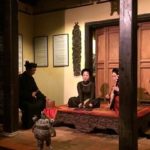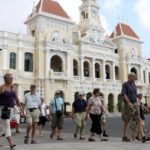In the bustling streets of Hanoi, it is common to find rows of only one or two types of trees. However, a visit to the beautiful Hoan Kiem Lake is a different experience altogether. Here, visitors are greeted by a magnificent collection of trees, representing a diverse array of over a dozen species. Among these remarkable trees, some have earned the esteemed recognition as “heritage trees” owing to their age and incredible allure, making them truly irreplaceable.
Two iconic phoenix trees on Le Thai To Street
| Two famous phoenix trees on Le Thai To Street form the romantic backdrop of Hoan Kiem Lake. Photo: Vietnam Tourism |
Discover the elegant charm of Dinh Tien Hoang Street, adorned with a picturesque stretch of ancient dragon plum trees extending from Hoa Phong Tower to the historic Hanoi Post Office. Enchantingly, the neighboring Dinh Le Street is also graced with these exquisite trees. During the months of March and April, these streets transform into a delightful symphony of yellow hues, as the fallen leaves of the dragon plum trees gracefully blanket their paths.
Approximately four decades ago, the people of Hanoi, including both children and adults, would venture up these trees to harvest the fruits that hung delicately in the sky, resembling music notes waiting to be played by the cicadas, creating a melodic summer symphony. The affection Hanoians hold for dragon plums is so deep that the late writer Bang Son eloquently expressed: “Dragon plums run in the veins of Hanoians, adding a touch of sourness to their essence”.
The ancient Bombax ceiba tree on Dinh Tien Hoang Street
As you stroll northwards, you will encounter a majestic Bombax ceiba tree, standing tall for over a century. The girth of its trunk is such that it requires the embrace of four adults with extended arms to encircle it completely. During the late spring season, the tree adorns itself with resplendent red blossoms, resembling the alluring lips of a maiden. Its enchanting beauty bewitches those who pass by, leaving them captivated in admiration.
Bombax ceiba trees hold a special place in the hearts of Vietnamese people, particularly those residing in the northern Delta and Central Highlands. Despite being less prevalent in the capital, these trees evoke nostalgic childhood memories for many individuals.
| Hoan Kiem Lake is adorned with the velvety red Hoa Gao or Bombax Ceiba flower every March. Photo: Reatimes |
The Ancient Mango Pine
Located just a short distance away, on the opposite side of the road, you will find Tran Nguyen Han Street where you will come across a noteworthy sight: an exquisite ancient mango pine tree accompanied by a cluster of nine Java olive trees. These trees have often been confused with a different species known as “nine-trunked mango-pine” due to their striking resemblance in shape and leaf color. It was only recently that they were correctly identified as mo trees, a Vietnamese name inspired by their brown fruits that resemble wooden fish.
During both spring and fall, the mango pine trees display their majestic beauty by blossoming thousands of red pendant flowers, reminiscent of the royal hairpins adorning a princess’s elegant hair. However, it is during winter when these trees, along with their nine neighboring companions, truly captivate with their vibrant yellow, orange, and red foliage, transforming a corner of Hoan Kiem Lake into a breathtaking sight.
The distinctive grouping of Nine Java olive trees
Professional Rewrite:
Renowned photographer, Trinh Linh Giang, captivated by the enchanting Loc Vung or Java olive trees, shared his profound sense of appreciation for their uniqueness. Reflecting on his journey as a photographer, he reminisced about his initial encounter with these magnificent trees roughly 15 years ago. Giang marveled at their blossoms during the spring season, and the remarkable transformation of their leaves into a vibrant yellow hue during the winter months. He noted that it is during these particular times that the trees radiate their most captivating allure.
| The Loc Vung tree at Sword Lake during the leaf changing season. Photo: Huy Pham |
The tree present near Hoan Kiem Lake stands as a magnificent ancient tree, notable for its immense size. It holds a special place in the hearts of the people of Hanoi, cherished and recognized by generations. Every time the tree blossoms or undergoes a change in its foliage, it entices countless locals and tourists to gather here and capture beautiful moments in photographs. Notably, during its mesmerizing yellow leaf transformation, this region captivates observers, resembling the enchanting autumn landscapes of Europe, Korea, or Japan.
Continuing along the spacious sidewalk, visitors will arrive at Ngoc Son Temple. Just beyond the exquisite Huc Bridge awaits a captivating realm of ancient curtain fig trees, with their captivating prop roots gracefully draping over the serene lake, reminiscent of the majestic beards of wise grandfathers. Amongst these trees, one has a remarkable tale of resilience, having been uprooted by a powerful storm only to be revived by the resilient locals. This extraordinary event is even commemorated in an excerpt from the distinguished short story “Mot Nguoi Ha Noi” (A Hanoian), featured in Vietnam’s esteemed 12th-grade literature textbook.
The Banyan Tree at Ba Kieu Temple
From the temple, one can admire the magnificent sight of the Monument of Self-Sacrificing Defenders, accompanied by a majestic banyan tree known as the Ba Kieu Temple Banyan Tree. This iconic tree has graced the temple grounds for centuries, adding to the historical allure of the area. According to local legend, the banyan tree grew around a red silk cotton tree that once stood in its place, further adding to the mystique and significance of this natural wonder.
Over time, the first tree perished, creating a void within the majestic banyan tree. This tale has become a cherished symbol of enduring love for the people of Hanoi, as it depicts a devoted couple who remained inseparable until one’s passing, leaving an irreplaceable void in the other’s soul.
| The marvelous ancient banyan tree and Ba Kieu temple are across from Hoan Kiem Lake. Photo: To Quoc Newspaper |
The scenic Dinh Tien Hoang Street culminates at Dong Kinh Nghia Thuc Square, offering visitors a captivating view. Nestled amidst the landscape is a rare and remarkable Bodhi tree adorned with heart-shaped leaves. Upon closer examination, one can also spot weathered strings encircling a prominent branch, strategically positioned towards the square. These strings were once employed to suspend a distinct mushroom-shaped loudspeaker.
During the 1960s and 1970s, the people of Hanoi would come together beneath the loudspeakers that were strategically placed throughout the city. It was under these speakers that they would listen to the poetic Tet wishes of Uncle Ho on the final lunar night. They would shed tears upon hearing news of the Great Leader’s illness and eventual passing in 1969. These speakers also served as a source of warning during the devastating bombings that occurred in the capital in 1972. Finally, they would erupt with joy on April 30, 1975, when Liberation Day was celebrated.
Located on Le Thai To Street in Hanoi, you will find the renowned Thuy Ta building and the iconic Thuy Ta ice cream shop. As you continue along this street, you will be greeted by a row of majestic khaya trees, which are characteristic of the French-influenced architecture in the area.
| Hoan Kiem Lake is brilliant with Lagerstroemia and Flamboyant Flowers in summer. Photo: Kien Truc Magazine |
While strolling along the western shore, one cannot miss the prominent headquarters of the Nhan Dan Newspaper situated just across the street. The newspaper’s courtyard is graced with the presence of a remarkable banyan tree that stands as a testament to history, believed to be over 300 years old. These majestic banyan trees symbolize the remnants of ancient Vietnamese villages, exuding a sense of heritage and cultural significance.
Intriguingly, it was under the shade of this very tree that in 1835, Vu Tong Phan established the Ho Dinh School. This renowned institution holds the distinction of being one of the earliest private schools in Thang Long, leaving an indelible mark on the Dong Kinh Nghia Thuc movement.
Such historical anecdotes and the breathtaking presence of this venerable banyan tree add a sense of enchantment to the downtown area. Visitors are invited to take a moment to reflect upon the rich cultural tapestry and deep-rooted traditions of Vietnam that thrive amidst the bustling cityscape.
The intersection of Le Thai To Street and Hang Khay Street is marked by a picturesque row of willow trees, which consistently lends a tranquil ambiance to the area. Additionally, there stands a magnificent saraca diving tree, soaring up to 20 meters in height. During the summer season, the vibrant orange blossoms of the diving tree, complemented by the striking red of the phoenix trees and the majestic purple hues of the giant crepe myrtle trees encircling the lake, transform the vicinity into a splendid floral paradise.
| The ancient fig tree next to the Pen Tower in Hoan Kiem Lake. File Photo |
The surrounding area boasts an impressive array of some noteworthy plant species. Among these are a total of 30 sua trees, with some dating back several decades, and a few even reaching the remarkable age of a century. Additionally, approximately 10 tamarind trees, approximately 130 years old, grace the landscape. A picturesque row of orchid trees adds to the scenery, alongside four magnificent giant taek trees and seven impressive tiger’s claw trees. Moreover, a delightful cluster of fig trees can be found in close proximity to Thap But, also known as Pen Tower.
According to the renowned writer Bang Son, the lush trees surrounding Hoan Kiem Lake are a unique and cherished feature of Hanoi. These trees have captivated the hearts of musicians, photographers, and even everyday individuals trying to make ends meet. Whether formally acknowledged or not, they are an essential part of the city’s heritage, serving as a haven for both locals and visitors, akin to a paradise within the bustling capital.
Ancient house in Ma May
NDO – Ma May, a rare quarter that still retains several old houses, has created one of the characteristics of Hanoi. Hanoi’s streets are becoming increasingly crowded and traditional features can sometimes be hidden behind modern life. But if one takes the time to relax and look around, the ancient features begin to reveal themselves.
Book festival “Hanoi – City for Peace” opens
NDO – The Hanoi book festival with the theme “Hanoi – City for Peace” opened at the Imperial Citadel of Thang Long in Hanoi on October 2, as part of activities to celebrate the 65th anniversary of the capital’s Liberation Day (October 10, 1954-2019).














